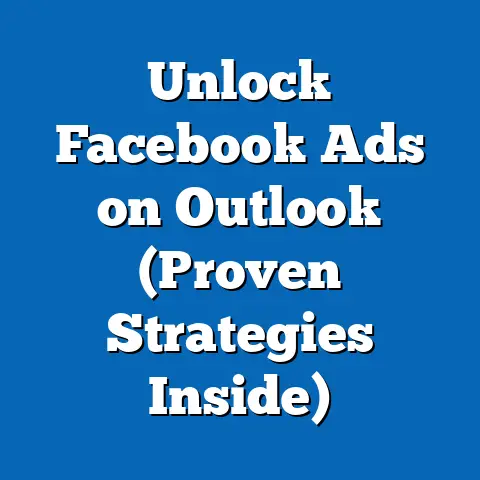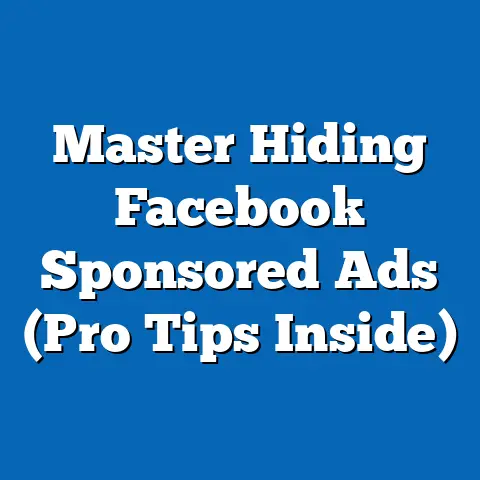Unlocking Facebook’s Ad Policies (Insightful Breakdown)
Facebook Ads has revolutionized how businesses, both big and small, connect with their target audiences. I remember when I first started using Facebook Ads back in 2010. It felt like the Wild West – targeting was basic, and the platform was still finding its footing. Fast forward to today, and it’s a sophisticated, data-driven powerhouse. But with great power comes great responsibility, and in the world of Facebook advertising, that responsibility translates to understanding and adhering to Facebook’s ad policies.
These policies aren’t just arbitrary rules; they’re the guardrails that ensure a safe, trustworthy, and positive experience for Facebook’s billions of users. And, let’s be honest, they can be a little tricky to navigate. I’ve seen firsthand how a seemingly innocent oversight can lead to ad disapprovals, account suspensions, and a whole lot of wasted time and money.
Understanding these policies is crucial not only for compliance but also for maximizing the effectiveness of your ad campaigns. Think of it this way: a compliant ad is a performing ad. By adhering to these guidelines, you enhance your brand reputation, build trust with your audience, and ultimately drive better results. This article is your guide to unlocking the secrets of Facebook’s ad policies, ensuring your campaigns are not only successful but also sustainable in the long run.
Section 1: Overview of Facebook Ad Policies
Facebook’s ad policies are a comprehensive set of guidelines that govern the type of content that can be advertised on the platform. These policies are designed to maintain a safe, respectful, and trustworthy environment for its users. They are regularly updated to reflect changes in societal norms, technological advancements, and emerging threats.
The primary categories of Facebook’s ad policies include:
- Prohibited Content: This category outlines the types of content that are strictly forbidden on Facebook. This includes things like hate speech, discriminatory practices, illegal products or services, and deceptive or misleading claims.
- Restricted Content: This category covers content that is allowed but requires special permission or adherence to specific guidelines. Examples include ads promoting alcohol, gambling, dating services, and health-related products.
- Community Standards: While not strictly “ad policies,” Facebook’s Community Standards heavily influence what is acceptable in advertising. These standards define what is and isn’t allowed on the platform in general, and ads are held to the same, if not higher, standard.
The rationale behind these policies is simple: Facebook wants to create a positive user experience. By preventing harmful, offensive, or misleading content, Facebook aims to build trust and encourage engagement.
I’ve learned over the years that understanding the why behind these policies is just as important as knowing the what. It helps you approach your ad creation with a more ethical and user-centric mindset.
Common Violations and Their Implications:
It’s easy to slip up, even with the best intentions. Some common violations I’ve seen include:
- Making exaggerated claims: Promising unrealistic results or using unsubstantiated testimonials.
- Targeting sensitive attributes: Using demographic targeting in a way that discriminates against certain groups.
- Promoting unsafe products: Advertising products that could potentially harm users, such as counterfeit goods or unapproved supplements.
The consequences of violating these policies can range from ad disapproval to permanent account suspension. In some cases, I’ve even seen businesses face legal repercussions for making false or misleading claims in their ads.
Takeaway: Facebook’s ad policies are in place to protect users and maintain a positive platform experience. Understanding these policies is crucial for creating compliant and effective ad campaigns.
Section 2: Prohibited Content
Let’s dive deeper into the specifics of prohibited content. This is where things get serious, as these are the types of content that will get your ads rejected faster than you can say “algorithm update.”
Here’s a breakdown of some key categories of prohibited content:
- Hate Speech: Any content that attacks, threatens, or dehumanizes individuals or groups based on protected characteristics like race, ethnicity, religion, gender, sexual orientation, disability, or medical condition.
- Example: An ad that promotes violence against a particular ethnic group.
- Adult Content: Ads that contain nudity, sexually suggestive imagery, or explicit descriptions of sexual acts.
- Example: An ad for lingerie that features overly revealing images.
- Misleading or Deceptive Claims: Ads that make false or unsubstantiated claims about products, services, or business practices.
- Example: An ad for a weight loss product that promises unrealistic results without scientific evidence.
- Illegal Products or Services: Ads that promote or facilitate the sale of illegal drugs, weapons, counterfeit goods, or other prohibited items.
- Example: An ad that offers to sell fake designer handbags.
- Sensational Content: Ads that contain graphic or violent content, or that exploit tragic events for commercial gain.
- Example: An ad that uses images of a natural disaster to promote a home insurance product.
- Personal Attributes: Ads that directly assert or imply a user’s personal attributes, such as their race, ethnicity, religion, sexual orientation, or medical condition. This is a tricky one!
- Example: An ad that says, “Are you divorced and looking for love?” is a violation because it directly implies a user’s marital status.
- Example: An ad that promotes violence against a particular ethnic group.
- Example: An ad for lingerie that features overly revealing images.
- Example: An ad for a weight loss product that promises unrealistic results without scientific evidence.
- Example: An ad that offers to sell fake designer handbags.
- Example: An ad that uses images of a natural disaster to promote a home insurance product.
- Example: An ad that says, “Are you divorced and looking for love?” is a violation because it directly implies a user’s marital status.
Real-World Examples:
To illustrate what constitutes a violation, consider these scenarios:
- A political ad that uses inflammatory language to demonize a particular candidate.
- An ad for a dating app that targets users based on their sexual orientation without proper disclosures.
- An ad for a dietary supplement that claims to cure a specific disease without FDA approval.
- An ad that uses clickbait headlines or deceptive images to trick users into clicking.
Consequences of Violating These Guidelines:
Running ads that violate these guidelines can have serious consequences:
- Ad Rejection: The most common consequence is simply having your ad rejected. This means it won’t be shown to anyone.
- Account Suspension: Repeated violations can lead to temporary or permanent suspension of your ad account.
- Page Restrictions: In some cases, Facebook may restrict the functionality of your Facebook Page, preventing you from running ads or posting content.
- Legal Repercussions: As I mentioned earlier, making false or misleading claims in your ads can lead to legal action from regulatory agencies or consumers.
Takeaway: Prohibited content is a no-go zone. Avoid these categories at all costs to ensure your ads are compliant and your account remains in good standing.
Section 3: Restricted Content
While prohibited content is strictly off-limits, restricted content is a bit more nuanced. These are categories of content that are allowed, but only under certain conditions. You’ll need special permission from Facebook and adhere to specific guidelines to promote these types of products or services.
Here’s a look at some common categories of restricted content:
- Alcohol: Ads promoting alcohol products are subject to age and location restrictions. You must ensure that your ads are only shown to users who are of legal drinking age in the targeted region.
- Example: An ad for a craft beer must be targeted to users who are 21 or older in the United States.
- Gambling: Ads promoting online casinos, sports betting, or other forms of gambling are heavily regulated. You’ll need to obtain written permission from Facebook and comply with all applicable local laws.
- Example: An ad for an online poker site must be targeted to users in jurisdictions where online gambling is legal.
- Dating Services: Ads for dating apps or websites are allowed, but you must avoid making overly sexual or suggestive claims. You also need to be transparent about your targeting practices.
- Example: An ad for a dating app that features diverse and respectful imagery.
- Health-Related Products: Ads promoting prescription drugs, medical devices, or other health-related products are subject to strict regulations. You’ll need to provide evidence that your products are safe and effective.
- Example: An ad for a blood pressure monitor that includes a disclaimer about consulting with a doctor.
- Cryptocurrency: Ads promoting cryptocurrency products and services have faced increased scrutiny in recent years. You’ll need to demonstrate that your business is legitimate and that you’re not engaging in any deceptive practices.
- Example: An ad for a cryptocurrency exchange that clearly discloses the risks involved.
- Example: An ad for a craft beer must be targeted to users who are 21 or older in the United States.
- Example: An ad for an online poker site must be targeted to users in jurisdictions where online gambling is legal.
- Example: An ad for a dating app that features diverse and respectful imagery.
- Example: An ad for a blood pressure monitor that includes a disclaimer about consulting with a doctor.
- Example: An ad for a cryptocurrency exchange that clearly discloses the risks involved.
The Approval Process:
To get approval for restricted content, you’ll typically need to:
- Review Facebook’s Advertising Policies: Familiarize yourself with the specific guidelines for the category of content you’re promoting.
- Provide Documentation: Submit any required documentation, such as licenses, permits, or certifications.
- Comply with Targeting Requirements: Ensure that your ads are targeted appropriately, based on age, location, and other relevant factors.
- Use Disclaimers: Include clear and conspicuous disclaimers about the risks involved or the limitations of your products or services.
- Monitor Your Ads: Regularly monitor your ads to ensure that they remain compliant with Facebook’s policies.
Case Studies:
I’ve worked with several clients in restricted industries, and I’ve seen firsthand what works and what doesn’t. For example, I helped a local brewery navigate the alcohol advertising restrictions by focusing on the brewery’s story, the quality of their ingredients, and the community events they hosted. We avoided overly suggestive imagery and focused on responsible enjoyment.
Another client, a telehealth company, successfully advertised their services by emphasizing convenience, affordability, and access to qualified medical professionals. We were careful to avoid making any unsupported claims about the effectiveness of their treatments.
Takeaway: Restricted content requires a careful and strategic approach. Obtain the necessary approvals, comply with all applicable guidelines, and prioritize transparency and responsible advertising.
Section 4: Best Practices for Compliance
Now that you understand the types of content that are prohibited or restricted, let’s talk about some best practices for ensuring compliance with Facebook’s ad policies.
- Regularly Review Policy Updates: Facebook’s ad policies are constantly evolving. Make it a habit to review the latest updates to stay informed about any changes that may affect your campaigns. You can find the most up-to-date policies on Facebook’s Business Help Center.
- Utilize Facebook’s Resources: Facebook provides a wealth of resources to help advertisers understand and comply with its policies. Take advantage of the Ads Manager, Help Center, and Community Forums.
- Be Transparent: Transparency is key to building trust with your audience and avoiding policy violations. Be upfront about your products, services, and business practices.
- Avoid Clickbait: Don’t use sensational headlines or deceptive images to trick users into clicking on your ads. This can lead to ad disapproval and damage your brand reputation.
- Focus on Value: Create ads that provide genuine value to your target audience. Focus on solving their problems, meeting their needs, or entertaining them.
- Test Your Ads: Before launching a new campaign, test your ads to ensure that they comply with Facebook’s policies. You can use the Ads Manager to preview your ads and identify any potential issues.
- Monitor Your Ads: Regularly monitor your ads to ensure that they remain compliant with Facebook’s policies. If you notice any issues, take immediate action to correct them.
- Use Third-Party Tools: Consider using third-party tools that can help you monitor your ads for compliance issues. These tools can automate the process of reviewing your ads and identifying potential violations.
- Educate Your Team: Make sure that everyone on your team understands Facebook’s ad policies and is committed to compliance. Provide regular training and updates to keep them informed.
The Role of Transparency:
I can’t stress enough how important transparency is. In today’s world, consumers are more discerning than ever. They want to know who they’re doing business with and what they stand for. By being transparent in your advertising, you can build trust and loyalty with your audience.
This means being honest about your products or services, disclosing any potential risks or limitations, and avoiding deceptive or misleading claims. It also means being transparent about your targeting practices and respecting users’ privacy.
Takeaway: Compliance is an ongoing process, not a one-time event. Stay informed, be transparent, and focus on providing value to your audience.
Section 5: Navigating the Appeals Process
Even if you follow all the best practices, there’s still a chance that your ads may be disapproved or your account may be suspended. It happens! Facebook’s algorithms aren’t perfect, and sometimes they make mistakes.
If this happens to you, don’t panic. You have the right to appeal the decision. Here’s how to navigate the appeals process:
- Review the Reason for Disapproval: The first step is to understand why your ad was disapproved or your account was suspended. Facebook will typically provide a reason for the decision in the Ads Manager or via email.
- Gather Evidence: Collect any evidence that supports your case. This could include documentation, testimonials, or screenshots.
- Contact Facebook Support: Contact Facebook Support to appeal the decision. You can do this through the Ads Manager or by visiting the Business Help Center.
- Explain Your Case: Clearly and concisely explain why you believe the decision was incorrect. Provide any relevant evidence to support your case.
- Be Polite and Professional: Remember that the Facebook Support team is there to help you. Be polite and professional in your communication.
- Be Patient: The appeals process can take time. Be patient and persistent, and don’t give up easily.
- Escalate if Necessary: If you’re not satisfied with the initial response, you can escalate your case to a higher level of support.
Tips for Constructing an Effective Appeal:
- Be Specific: Clearly explain which policy you believe you’re not violating and why.
- Provide Context: Offer any relevant context that might help Facebook understand your ad.
- Acknowledge the Policy: Show that you understand the policy in question and that you’re committed to complying with it.
- Offer a Solution: If you made a mistake, offer a solution to correct it.
- Be Concise: Keep your appeal short and to the point.
I remember one time when an ad for a client’s yoga studio was disapproved because the algorithm mistakenly flagged it as promoting “adult content.” The image in the ad featured a group of people doing yoga poses, but apparently, the algorithm misinterpreted some of the poses as suggestive.
We appealed the decision by explaining that the ad was for a legitimate yoga studio and that the image was simply depicting people doing yoga. We also provided additional images of the studio and its instructors to demonstrate that it was a professional business.
After a few days, Facebook overturned the decision and approved the ad.
Takeaway: Don’t be afraid to appeal a decision if you believe it’s incorrect. Be prepared to provide evidence and explain your case clearly and concisely.
Conclusion
Understanding and adhering to Facebook’s ad policies is essential for unlocking the full potential of advertising on the platform. These policies are designed to protect users, maintain a positive platform experience, and ensure that ads are relevant and trustworthy.
By following the guidelines outlined in this article, you can create compliant and effective ad campaigns that drive results. Remember to:
- Stay informed about the latest policy updates.
- Utilize Facebook’s resources.
- Be transparent in your advertising.
- Avoid prohibited content.
- Comply with the guidelines for restricted content.
- Appeal decisions if you believe they’re incorrect.
A thorough understanding of these policies not only protects your business from penalties but also enhances your overall advertising strategy. By creating ads that are compliant, relevant, and valuable, you can build trust with your audience, improve your brand reputation, and drive better results.
So, go forth and advertise responsibly! Stay informed, be proactive, and unlock the full potential of Facebook advertising. I’m confident that with a solid understanding of these policies, you can achieve your business goals while contributing to a positive and trustworthy advertising ecosystem.






